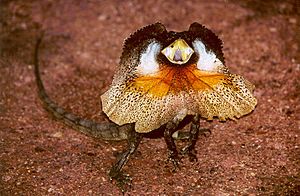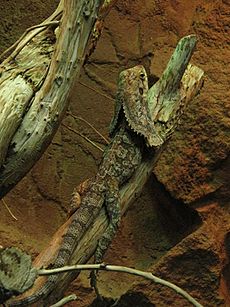Frill-necked Lizard facts for kids
Quick facts for kids Frill-necked lizard |
|
|---|---|
 |
|
| Scientific classification | |
| Kingdom: | |
| Phylum: | |
| Class: | |
| Order: | |
| Suborder: | |
| Infraorder: | |
| Family: | |
| Subfamily: |
Agaminae
|
| Genus: |
Chlamydosaurus
|
| Binomial name | |
| Chlamydosaurus kingii Gray, 1827
|
|
The frilled-necked lizard (Chlamydosaurus kingii) is a very unique lizard. People also call it the frilled lizard, frilled dragon, or frilled agama. It lives mostly in northern Australia and southern New Guinea. This amazing lizard is the only type in its group, called Chlamydosaurus.
Its name comes from the big, loose skin around its neck. This skin, called a frill, usually stays folded back against its body. Frilled-necked lizards spend most of their time in trees. They mainly eat insects and small animals. These lizards can grow quite large, up to about 85 centimeters (33 inches) long, including their tail. Some people even keep them as exotic pets.
Because of its cool look, the frilled-necked lizard often appears in cartoons and movies.
Contents
What Does a Frill-necked Lizard Look Like?
The frill-necked lizard is a large member of the agamid family. It can grow up to 85 centimeters (33 inches) long. These lizards can even run on two legs! Naturalists (people who study nature) have seen them walk with a clear, purposeful stride.
Their skin color is usually brown or gray. They have darker spots and blotches that look like tree bark. Their color changes depending on where they live. For example, a lizard from a dry, clay area might have colors like orange, red, and brown. A lizard from a wet, tropical area will likely be darker brown and gray. This helps them blend in with their surroundings, which is a type of camouflage.
The most special part of these lizards is their large frill. This skin usually rests folded against their head and neck. Long pieces of cartilage, connected to their jawbones, support the frill. When the lizard gets scared, it puts on a surprising show! It opens its mouth wide, showing a bright pink or yellow inside. It spreads out its frill, which has bright orange and red scales. It also raises its body and sometimes lifts its tail. This display helps them protect their territory, scare off predators, and attract a mate.
The bones that support the frill are special hyoid bones. When the frill is relaxed, it also helps the lizard hide. The lizard's body color is usually darker than its frill.
Where Do Frill-necked Lizards Live?
Frill-necked lizards are mostly found in northern Australia and southern New Guinea. Sometimes, they are seen in the drier desert areas of Australia. However, they prefer humid places like tropical savannah woodlands.
They are mostly arboreal lizards, meaning they spend most of their time in trees. They only come down to the ground to find food or to fight over territory. Living in trees helps them find food, which includes small arthropods (like insects) and small vertebrates (like other small lizards). Most importantly, trees offer great camouflage for them.
What Do Frill-necked Lizards Eat?
Like many lizards, frill-necked lizards are carnivores, meaning they eat meat. They enjoy eating cicadas, beetles, termites, and even mice. They especially love butterflies, moths, and their young (larvae). While insects are their main food, they also eat spiders and sometimes other lizards.
Frill-necked lizards are ambush hunters. This means they wait quietly for their prey to come close. When they find food, they eat a lot! These big eating times usually happen during the wet season. During this time, they might eat hundreds or thousands of flying ants or termites.
How Do Frill-necked Lizards Control Their Body Temperature?
Frill-necked lizards are ectothermic. This means they rely on their surroundings to control their body temperature. They warm up by basking (lying in the sun) for a short time. This helps them get their body temperature a few degrees warmer than the air around them.
They usually bask in the morning to early afternoon to get the most sunlight. Their final body temperature mostly depends on how warm the air is. People once thought the frill helped them control their temperature, but scientists have found this is not true.
Who Are the Predators of Frill-necked Lizards?
The main animals that hunt frill-necked lizards are eagles, owls, larger lizards, snakes, dingos, and quolls.
Frill-necked Lizards in Culture
A frill-necked lizard was shown on the back of the Australian two-cent coin until 1991. A frill-necked lizard named "Lizzie" was also the mascot for the 2000 Summer Paralympics in Sydney. The frill-necked lizard is also the symbol for NORFORCE, an Australian Army unit that patrols parts of northern Australia.
Because of its unique look and behavior, the frill-necked lizard is often seen in movies and on TV. A frill-necked lizard named Frank appears in the Disney film The Rescuers Down Under. In the movie Jurassic Park, the dinosaur Dilophosaurus was shown with a neck frill that opened up when it attacked, just like a frilled-neck lizard. This movie made many people want frill-necked lizards as pets. In the animated film Blinky Bill the Movie and the TV shows The Wild Adventures of Blinky Bill, there's a frill-necked lizard named Jacko who wears a black t-shirt.
Images for kids
See also
 In Spanish: Clamidosaurio de King para niños
In Spanish: Clamidosaurio de King para niños








